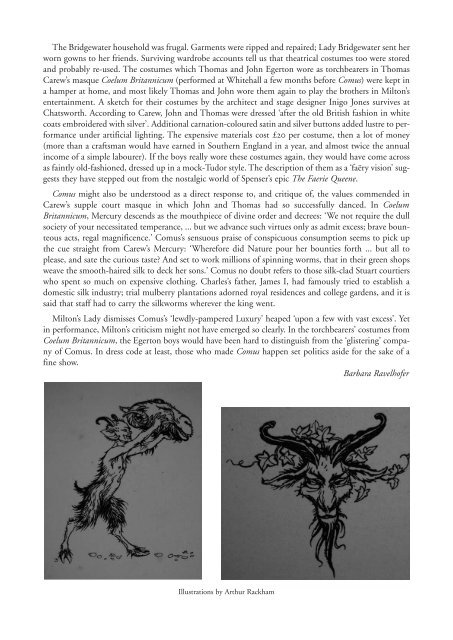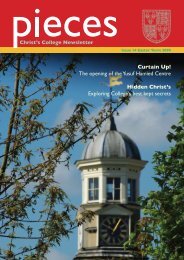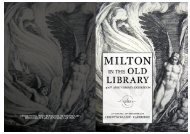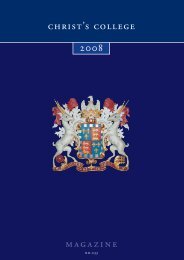here - Christ's College - University of Cambridge
here - Christ's College - University of Cambridge
here - Christ's College - University of Cambridge
You also want an ePaper? Increase the reach of your titles
YUMPU automatically turns print PDFs into web optimized ePapers that Google loves.
The Bridgewater household was frugal. Garments were ripped and repaired; Lady Bridgewater sent her<br />
worn gowns to her friends. Surviving wardrobe accounts tell us that theatrical costumes too were stored<br />
and probably re-used. The costumes which Thomas and John Egerton wore as torchbearers in Thomas<br />
Carew’s masque Coelum Britannicum (performed at Whitehall a few months before Comus) were kept in<br />
a hamper at home, and most likely Thomas and John wore them again to play the brothers in Milton’s<br />
entertainment. A sketch for their costumes by the architect and stage designer Inigo Jones survives at<br />
Chatsworth. According to Carew, John and Thomas were dressed ‘after the old British fashion in white<br />
coats embroidered with silver’. Additional carnation-coloured satin and silver buttons added lustre to performance<br />
under artificial lighting. The expensive materials cost £20 per costume, then a lot <strong>of</strong> money<br />
(more than a craftsman would have earned in Southern England in a year, and almost twice the annual<br />
income <strong>of</strong> a simple labourer). If the boys really wore these costumes again, they would have come across<br />
as faintly old-fashioned, dressed up in a mock-Tudor style. The description <strong>of</strong> them as a ‘faëry vision’ suggests<br />
they have stepped out from the nostalgic world <strong>of</strong> Spenser’s epic The Faerie Queene.<br />
Comus might also be understood as a direct response to, and critique <strong>of</strong>, the values commended in<br />
Carew’s supple court masque in which John and Thomas had so successfully danced. In Coelum<br />
Britannicum, Mercury descends as the mouthpiece <strong>of</strong> divine order and decrees: ‘We not require the dull<br />
society <strong>of</strong> your necessitated temperance, ... but we advance such virtues only as admit excess; brave bounteous<br />
acts, regal magnificence.’ Comus’s sensuous praise <strong>of</strong> conspicuous consumption seems to pick up<br />
the cue straight from Carew’s Mercury: ‘W<strong>here</strong>fore did Nature pour her bounties forth ... but all to<br />
please, and sate the curious taste? And set to work millions <strong>of</strong> spinning worms, that in their green shops<br />
weave the smooth-haired silk to deck her sons.’ Comus no doubt refers to those silk-clad Stuart courtiers<br />
who spent so much on expensive clothing. Charles’s father, James I, had famously tried to establish a<br />
domestic silk industry; trial mulberry plantations adorned royal residences and college gardens, and it is<br />
said that staff had to carry the silkworms w<strong>here</strong>ver the king went.<br />
Milton’s Lady dismisses Comus’s ‘lewdly-pampered Luxury’ heaped ‘upon a few with vast excess’. Yet<br />
in performance, Milton’s criticism might not have emerged so clearly. In the torchbearers’ costumes from<br />
Coelum Britannicum, the Egerton boys would have been hard to distinguish from the ‘glistering’ company<br />
<strong>of</strong> Comus. In dress code at least, those who made Comus happen set politics aside for the sake <strong>of</strong> a<br />
fine show.<br />
Barbara Ravelh<strong>of</strong>er<br />
Illustrations by Arthur Rackham





